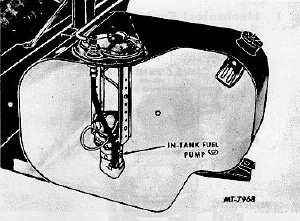|
| |
TRUCK SERVICE MANUAL
TM 5-4210-230-14&P-1
FUEL SYSTEM
ing solvent. Blow dry with compressed air. In some cases
where the paper filter -s used, it is advisable to simply replace
the filter. This is particularly true where fuel additives are
used. Such additives can become trapped in filters, and their
accumulation may cause a restriction in flow. Restricted
filters are usually slippery to the touch.
When reinstalling the fuel filter and bowl always
make sure the gasket and spring are in place and that the
retainer screw is tight enough to prevent leakage. A leak at
the gasket will cause erratic action of the pump and thus
retard fuel delivery to the carburetor.
REPAIR OR REPLACEMENT
If it has been determined that fuel system troubles
are being caused by a faulty fuel pump, then the pump can
either be repaired or replaced. Instructions on the different
types of fuel pumps are covered in subsequent paragraphs.
If fuel trouble is encountered on any chassis having
an electric fuel pump, Fig. 2, and the pump is suspected,
check the pump as follows: Disconnect the fuel line at the
carburetor or transfer pump and turn on the ignition switch. If
ample fuel flows, you do not have pump trouble. If the pump
races but fuel does not flow in sufficient volume, the cause is
an air leak in the suction portion of the fuel system (no fuel).
If fuel does not flow at all, inspect the fuel lines or filters for
restrictions or check the electrical connections for a shorted or
open circuit. If all is in order and the pump still does not
operate, remove the pump and replace.
INSTALLATION
Mechanical Fuel Pump
Be sure to use a new mounting gasket between the
mechanical fuel pump mounting flange and the pad on the
crankcase when mounting the pump on the engine. Tighten
the capscrews securely.
Connect the fuel lines, first making sure that there is
no dirt on the fittings which might be drawn into the system.
If the carburetor has not been removed, there will
usually be sufficient fuel in it to run the engine long enough to
fill the fuel pump filter bowl. If there is an air leak between the
filter bowl and gasket, the pump cannot draw fuel into the
bowl. To remedy this, install a new gasket and see that the
bowl seats squarely. Tighten the retainer screw securely with
the fingers only.
If the fuel pump bowl still does not fill, the trouble
may be due to an air-bound condition. In this case, the bowl
should be loosened slightly so that the air can escape, and by
blowing in the gasoline tank filler neck, fuel will be forced into
the pump. Then tighten the bowl securely and start the
engine.
Electrical Fuel Pump (In-Tank Mounted)
(Gasoline Engines)
Connect the fuel lines, first making sure that there is no dirt on
the fittings which might be drawn into the system.
After the pump is installed and fuel and electrical
connections are made, turn on the ignition switch. If ample
fuel flows, there is no trouble with the pump. If the pump
races but there is no fuel flow, there is an air leak in the
suction portion of the fuel system or no fuel in the tank. If no
fuel flows at all, inspect the fuel lines or filters for restrictions
or check electrical connections for open or shorted circuits.
(Diesel Engines)
For the most part the installation instructions for the
electrical fuel pump used on diesel engines is the same as
used on gasoline engines, except that air can be introduced to
the fuel system even on the output side of the pump, since the
transfer pump could suck air if a filter or fuel line were
restricted.
Fig. 3 Cutaway View of a Fuel Tank with an
Electric In-Tank Mounted Fuel Pump
PRIMING DIESEL ENGINE FUEL SYSTEM (General)
Most vehicles are now equipped with an electric
primer switch which is located on the instrument panel and is
used to purge air from the fuel system.
CTS-2050-F
Page 4
PRINTED IN UNITED STATES OF AMERICA
|

